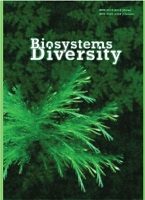Application of hemeroby and naturalness indicators for monitoring the aquatic macrophyte communities in protected areas
Application of hemeroby and naturalness indicators for monitoring the aquatic macrophyte communities in protected areas
Author(s): O. Lisovets, O. Khrystov, O. M. Kunakh, O. ZhukovSubject(s): Energy and Environmental Studies, Environmental Geography, Environmental interactions
Published by: Дніпропетровський національний університет імені Олеся Гончара
Keywords: nature protection; innovative projects; monitoring; bioindication; environmental impact assessment;
Summary/Abstract: The article discusses the application of hemeroby and naturalness indicators for monitoring the state of aquatic macrophytes in protected areas, taking into account the ecological characteristics of plant community syntaxons. Naturalness and hemeroby are considered as potential indicators of the state of aquatic ecosystems and the level of their anthropogenic transformation. Naturalness indicates the proximity of the community to the most natural state, and hemeroby indicates the level of anthropogenic transformation of the ecosystem. The vegetation cover of macrophytic communities of the “Dnipro-Orilskiy" Nature Reserve is represented by eight associations. Their differentiation is due to natural factors and factors caused by anthropogenic impact. The recorded plant communities demonstrate a compact spatial distribution. The Nymphaeo albae-Nupharetum luteae community occurs in the Dnipro riverbed. The Ceratophyllo-Hydrocharitetum associations were typical of the Orilsky Canal water bodies and were also found in Lake Sokilky, which is part of the Mykolaivka ledge system. The association's communities are common in the middle and lower reaches of the Dnipro. They are widespread in non-flowing water bodies with poor water exchange, neutral or slightly alkaline reaction of the environment in habitats protected from the wind, with water depth up to 50 cm, silted bottom sediments with a significant thickness of detritus and water transparency up to 15 cm. They are found in water bodies with excessive anthropogenic eutrophication processes. The Typhetum latifoliae association occurs in the system of the Obukhivka ledge system. The Salvinio-Hydrocharitetum association occurs mainly in the water bodies of the Taromske ledge system. The Hydrocharito Stratiotetum aloidis association occurs in the water bodies of the Mykolaivka ledge system adjacent to the first floodplain terrace of the Dnipro. The Lemno-Hydrocharitetum morsus-ranae association is found in the streams of the Mykolaivka ledge system. The Myriophylletum spicati association occurs in the bays of the Mykolaivka ledge system, which directly border the Dnipro riverbed. The Trapetum natantis association occurs in the water bodies of the Mykolaivka and Taromske ledge system. The close spatial relationship of macrophyte associations with geomorphic areas of the Dnipro floodplain can help reconstruct the events that led to the current appearance of plant communities. It has been shown that the morphology of water bodies and their water properties largely determine the spatial distribution of aquatic macrophytes. The study has shown that climate continentality is an important differentiating factor that determines the characteristics of the vegetation cover of aquatic macrophytes. The Typhetum latifoliae association differs from others by the dominance of plants with a range that is widespread in Eastern Europe. This association is found in the water bodies of the Obukhivka ledge system, where specific environmental conditions are formed. These include significantly higher water salinity, shallow water that warms up well, and relatively high nutrient supply. It is also worth noting the low naturalness, which can be explained by the high level of coastal erosion, which causes secondary vegetation succession. The decrease in naturalness may be the result of increased secondary succession. The high level of naturalness of the communities indicates the role of the protected area regime in the conservation of biodiversity. However, the protected area regime alone cannot protect the reserve from the impact of a complex of anthropogenic factors. The anthropogenic transformation of plant communities is caused by eutrophication, which depends on both the availability of excessive nutrients and water temperature. Refugia of the rheophilic regime in the Dnipro floodplain form biodiversity centers that are highly natural and have significant conservation value. Indicators of naturalness and hemeroby are sensitive markers of the state of plant communities that can be used in the practice of biological monitoring in protected areas.
Journal: Biosystems Diversity
- Issue Year: 32/2024
- Issue No: 2
- Page Range: 270-277
- Page Count: 8
- Language: English

